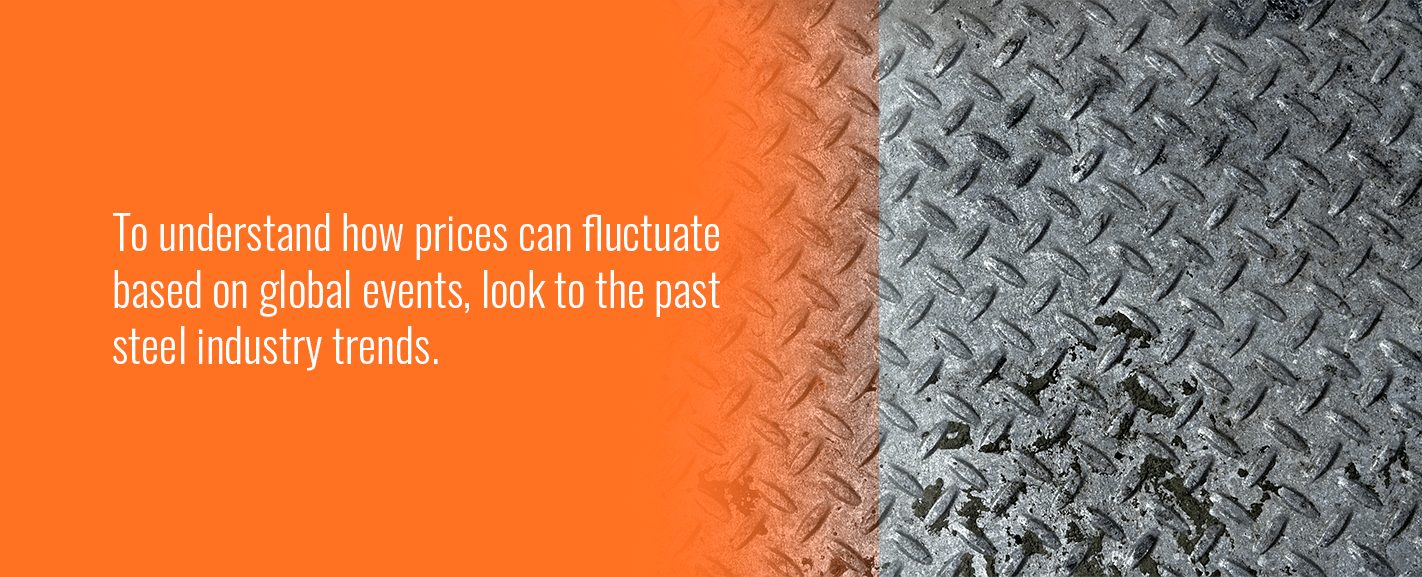
Steel prices fluctuated greatly throughout the past few years because of multiple factors. Understanding the reasoning behind steel price changes allows you to plan ahead based on pricing projections. Major world events, from pandemics to wars, cause instability in the industry, supply chain and pricing.
Explore more steel industry insights below.
The cost of steel is always fluctuating, and there are multiple reasons why. Steel prices can be attributed to various constantly changing factors, such as:
With so many factors at play, anticipating the changing prices can be tough. Unforeseen events also contribute to steel market volatility.

To understand how prices can fluctuate based on global events, look to the past steel industry trends. Because of COVID-19, many industries experienced significant setbacks, and the steel sector is no exception. The temporary shutdown of construction projects and steel production led to companies stopping worldwide steel manufacturing and distribution. As a result, steel supplies tightened, and prices increased.
In the last quarter of 2020, steel prices spiked. The dramatic increase directly resulted from COVID-19 and its impact on the steel industry. The steel sector experienced a significant amount of fluctuation due to the pandemic.
In the following year, steel prices were still on the rise. For instance, hot-rolled steel prices were less than $500 per ton in September 2020. By September 2021, the peak price was $1,955 per ton. That is a nearly 300% increase over just 12 months.
Throughout 2022, steel prices trended downward. As of November of that year, hot-rolled steel was priced at less than $700 per ton due to global factors such as spiraling inflation and ongoing supply-chain hiccups slowing many manufacturing operations across different industries.
The steel industry has seen some instability throughout past years. While supply and demand fluctuate, the market’s capacity to grow can change, as well.
While the steel industry continues to recover from the lingering effects of the COVID-19 pandemic, it is not out of the woods yet. Other global influences can continue to cause supply and demand instability.
The industry’s future is largely dependent on the outcomes and influences of high global inflation rates and world conflicts. These factors, among others, will determine what happens.
Ultimately, the predictions about what is ahead for the steel industry are highly uncertain. In the past, steel demand was continuously on the rise, paired with economic growth that was much more stable prior to the pandemic.
With so much at stake and in flux regarding the global economy, making accurate forecasts about the steel industry’s future is nearly impossible. Predicting steel demand may be more complicated and challenging than ever before. That said, some industry experts do anticipate industry growth in the coming years.
Manufacturers need to keep an eye on changing steel industry trends. Monitoring price fluctuations allows businesses to make more strategic sourcing decisions. Companies must strive to control overhead costs to the best of their ability to remain competitive in the face of unstable steel prices.
For over 70 years, PBZ has worked with our customers to provide custom manufacturing solutions. We’ll work with you to meet your needs while reducing costs with our streamlined processes.
Are you interested in learning more about how PBZ Manufacturing can help with various stages of your manufacturing operation, including fabrication and logistics? Contact us today for a free quote or call 717-584-8767 to get started.